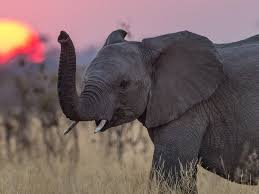(单词翻译:单击)
Leaders
来源于《社论》版块
Endangered specie
濒于灭绝的物种
The elephant in the room
屋中象
Now is not the time to liberalise the trade in endangered species
现在不是放开濒危物种贸易的时候
Nearly 6,000 species of animals and about 30,000 species of plants are listed in the various appendices of the Convention on International Trade in Endangered Species (CITES) to protect them against over-exploitation. But as CITES convenes its three-yearly decision-making conference in Geneva this month, one animal, as so often in the past, will attract much of the attention: the African elephant.
《濒危物种国际贸易公约》的各种附录中列出了近6000种动物和约30000种植物,以保护它们免受过度开发。但是,当《濒危物种国际贸易公约》于本月在日内瓦召开其三年一度的决策会议时,一种动物将像过去经常出现的那样,吸引大量的注意力:非洲象。

The elephant is in many ways CITES’s mascot. It was rescued in 1989 from what seemed inevitable extinction after half the population had been wiped out by poaching in just a decade. That year elephants were included in CITES’s Appendix I, under which virtually all international trade in their products is banned. The slaughter slowed. This month’s meeting will consider competing proposals about how absolute the ban should be, since in some countries elephant populations have recovered. Countries seeking a modest relaxation have a strong case to make. But it is not strong enough. The ban must stay.
大象在很多方面都是《濒危物种国际贸易公约》的吉祥物。1989年,在短短10年的时间里,一半的大象因为偷猎而灭绝。那一年,大象被列入《濒危野生动植物种国际贸易公约》的附录一,根据附录一,几乎所有大象产品的国际贸易都被禁止。对大象的屠杀放缓了。本月的会议将审议关于禁令的绝对程度的竞争性提案,因为在一些国家,大象的数量已经恢复。寻求适度放松的国家有充分的理由。但理由不够强大。禁令必须保留。
Understandably, countries that have done a good job protecting their elephants feel this is unfair. They point out that they have devoted huge resources to the elephant, through the costs of law enforcement alone. And the real burden of all this is borne by poor local people who are in competition with wildlife for resources, and sometimes in conflict with it—elephants can be destructive. People and governments, so the argument goes, need to have an economic stake in the elephants’ survival. The ivory trade would give them one.
那些在保护大象方面做得很好的国家认为不公平,这是可以理解的。这些国家指出,仅通过执法成本,就已经为大象投入了大量资源。而所有这一切的真正负担是由当地的穷人来承担的,他们与野生动物争夺资源,有时甚至与野生动物发生冲突——大象可能具有破坏性。按照这种观点,人民和政府需要在大象的生存上有经济利益。象牙贸易会提供一个机会。
That’s why Zambia wants its elephants moved to the slightly less restrictive Appendix II, which would allow some trade in, for example, hunting trophies. Four other southern African countries (Botswana, Namibia, South Africa and Zimbabwe), whose elephants were moved to Appendix II 20 years ago, want to be allowed to trade in their products, which, despite the change in status, they have mostly been prohibited from doing.
这就是为什么赞比亚希望自己国家的大象被转移到稍微宽松一些的附录II,这将允许一些贸易,例如,狩猎战利品。其他四个南部非洲国家(博茨瓦纳、纳米比亚、南非和津巴布韦)的大象在20年前被移至附录II,这些国家希望被允许交易产品,尽管地位发生了变化,但基本上被禁止这样做。
译文由可可原创,仅供学习交流使用,未经许可请勿转载。


